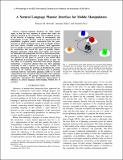| dc.contributor.author | Tellex, Stefanie | |
| dc.contributor.author | Howard, Thomas M. | |
| dc.contributor.author | Roy, Nicholas | |
| dc.date.accessioned | 2017-01-13T21:50:08Z | |
| dc.date.available | 2017-01-13T21:50:08Z | |
| dc.date.issued | 2014-05 | |
| dc.identifier.isbn | 978-1-4799-3685-4 | |
| dc.identifier.uri | http://hdl.handle.net/1721.1/106494 | |
| dc.description.abstract | Natural language interfaces for robot control aspire to find the best sequence of actions that reflect the behavior intended by the instruction. This is difficult because of the diversity of language, variety of environments, and heterogeneity of tasks. Previous work has demonstrated that probabilistic graphical models constructed from the parse structure of natural language can be used to identify motions that most closely resemble verb phrases. Such approaches however quickly succumb to computational bottlenecks imposed by construction and search the space of possible actions. Planning constraints, which define goal regions and separate the admissible and inadmissible states in an environment model, provide an interesting alternative to represent the meaning of verb phrases. In this paper we present a new model called the Distributed Correspondence Graph (DCG) to infer the most likely set of planning constraints from natural language instructions. A trajectory planner then uses these planning constraints to find a sequence of actions that resemble the instruction. Separating the problem of identifying the action encoded by the language into individual steps of planning constraint inference and motion planning enables us to avoid computational costs associated with generation and evaluation of many trajectories. We present experimental results from comparative experiments that demonstrate improvements in efficiency in natural language understanding without loss of accuracy. | en_US |
| dc.description.sponsorship | United States. Office of Naval Research. Multidisciplinary University Research Initiative (Grant N00014-09-1-1052) | en_US |
| dc.description.sponsorship | U.S. Army Research Laboratory. Collaborative Technology Alliance Program. (Cooperative Agreement W911NF-10-2-0016) | en_US |
| dc.language.iso | en_US | |
| dc.publisher | Institute of Electrical and Electronics Engineers (IEEE) | en_US |
| dc.relation.isversionof | http://dx.doi.org/10.1109/ICRA.2014.6907841 | en_US |
| dc.rights | Creative Commons Attribution-Noncommercial-Share Alike | en_US |
| dc.rights.uri | http://creativecommons.org/licenses/by-nc-sa/4.0/ | en_US |
| dc.source | MIT web domain | en_US |
| dc.title | A natural language planner interface for mobile manipulators | en_US |
| dc.type | Article | en_US |
| dc.identifier.citation | Howard, Thomas M., Stefanie Tellex, and Nicholas Roy. “A Natural Language Planner Interface for Mobile Manipulators.” IEEE, 2014. 6652–6659. | en_US |
| dc.contributor.department | Massachusetts Institute of Technology. Computer Science and Artificial Intelligence Laboratory | en_US |
| dc.contributor.department | Massachusetts Institute of Technology. Department of Aeronautics and Astronautics | en_US |
| dc.contributor.mitauthor | Howard, Thomas M. | |
| dc.contributor.mitauthor | Roy, Nicholas | |
| dc.relation.journal | IEEE International Conference on Robotics and Automation, 2014. ICRA '14 | en_US |
| dc.eprint.version | Author's final manuscript | en_US |
| dc.type.uri | http://purl.org/eprint/type/ConferencePaper | en_US |
| eprint.status | http://purl.org/eprint/status/NonPeerReviewed | en_US |
| dspace.orderedauthors | Howard, Thomas M.; Tellex, Stefanie; Roy, Nicholas | en_US |
| dspace.embargo.terms | N | en_US |
| dc.identifier.orcid | https://orcid.org/0000-0002-8293-0492 | |
| mit.license | OPEN_ACCESS_POLICY | en_US |
